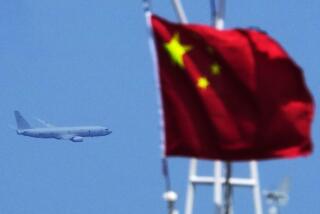Marking 25th anniversary of China’s Tiananmen Square takes creativity
- Share via
Reporting from BEIJING — Show tunes. Confetti. A deck of cards. Rubber ducks. A pornographic video.
These are some of the props in the annual games underway in Beijing as the most sensitive day of the year approaches. Wednesday is the 25th anniversary of the day when Communist Party leaders sent the military to clear pro-democracy students from Tiananmen Square.
Every year, political activists try to commemorate the hundreds if not thousands of people who died in the crackdown, and the Chinese government tries to prevent them, a cat-and-mouse game as classic as “Tom and Jerry.”
Except in China the mouse rarely wins.
One activist group, using the website backtotiananmen.com, is calling for people to flock to the square on Wednesday. Since it is impossible to hold banners or chant slogans without risking immediate arrest, the organizers suggest that people sing “Do You Hear the People Sing?” from “Les Miserables” — the tune from the finale in which Parisians rise up against tyranny.
“If they are too frightened to sing, they can just hum the tune,” said Wen Yunchao, an activist now in New York. “And if they can’t hum, they will show their support just by being there.”
Wen’s group found a unique way to publicize its movement: When a video leaked onto the Internet last month that purportedly shows a soap opera actress in a sex act, the group edited it to add in messages to show up at the square June 4. Of course, Chinese censors removed the video — pornography is banned along with political activism in China — but not quickly enough.
“It had already been downloaded thousands of times,” Wen said.
There are other ways of commemorating the day short of actually demonstrating. Activists also suggest that people toss white paper, confetti-style, from high-rise buildings in Beijing to mourn the spirits of those killed at the square.
Most of the activists organizing such events are overseas, not surprising given that the government has shown zero tolerance for anybody so much as mentioning Tiananmen. People have been detained or placed under house arrest to prevent them from holding activities marking the anniversary.
Amnesty International said last week that dozens of people had been confined, including the Beijing-based activist Hu Jia, who threatened to hold a hunger strike to commemorate the anniversary, and the now-elderly parents of the students killed in 1989. Also detained are people who held commemorative events in their homes.
“This year is the first time that events held in private behind closed doors were banned,” said Louisa Lim, author of the recently published “The People’s Republic of Amnesia: Tiananmen Revisited,” about the suppression of memories about the event.
Commemorating clearly requires creativity. Puns and euphemism come in handy. The crackdown on the pro-democracy movement is usually referred to in China simply by the date, June 4, and the numbers 6/4 are used to convey the enormity of the tragedy in much the same way Americans refer to the attacks of Sept. 11, 2001, as 9/11.
One activist took a picture at the square showing playing cards displaying 8964, in reference to the date, and AK47, referring to the rifles.
During the 20th anniversary in 2009, activists managed to slip an advertisement into a newspaper showing people standing in contemplation on a mountain, six on one side and four on another.
Because censors will often block references to the date, people sometimes refer to it as May 35. Or 63+1 or 65-1. As the date gets closer, even words as innocuous as “tomorrow” and “today” are often banned from the Chinese Internet.
Other people play with the most famous image of the protest movement: the lone activist who has come to be known as “Tank Man,” photographed standing in front of a column of military tanks. Homages to the famous photograph abound.
Last year, an artist posted a photo mash-up of the activist online, but substituted giant rubber ducks for the tanks. Another used mock-ups of tanks made out of Legos.
In 2008, the Beijing News, in an article about Pulitzer Prize-winning photographer Liu Heung Shing, apparently inadvertently published another iconic photograph, which shows a bicycle cart driver transporting two young men who had been shot to the hospital.
So successful had the Chinese government been in scrubbing memories of Tiananmen Square from the public consciousness that the editors at Beijing News didn’t recognize the image.
More to Read
Sign up for Essential California
The most important California stories and recommendations in your inbox every morning.
You may occasionally receive promotional content from the Los Angeles Times.










